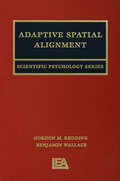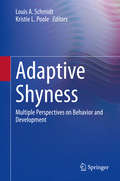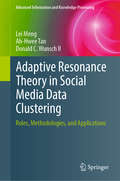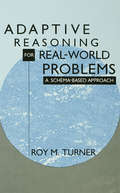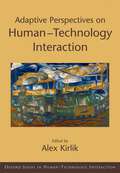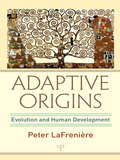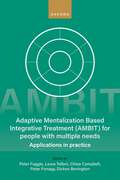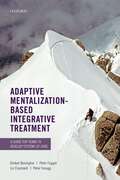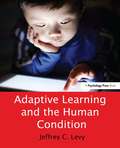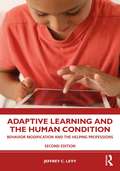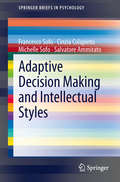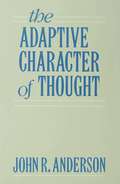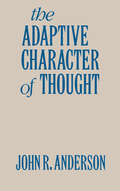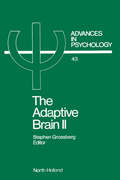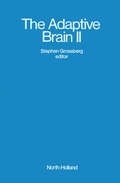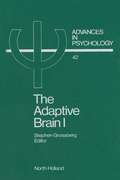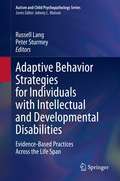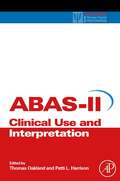- Table View
- List View
Adaptive Spatial Alignment (Scientific Psychology Series)
by Gordon M. Redding Benjamin WallaceFor most people, prism adaptation is an amusing demonstration, first experienced perhaps in an introductory psychology course. This monograph relates this peculiar phenomenon to the larger context of cognitive science, especially motor control and learning. The first part sketches the background concepts necessary to understand the contribution of prism adaptation to the larger issue of adaptive perceptual-motor performance including: * a review of the basic concepts of motor control and learning that enable strategic response in the prism adaptation situation; * the development of a hypothesis about spatial representation and spatial mapping and an introduction to the basic idea of adaptive spatial alignment; and * a contrasting view of perceptual and motor learning and a review of evidence for the involvement of nonassociative and associative learning in prism adaptation. Directly concerned with data and theory in prism adaptation, the second part presents: * an outline of prism adaptation methodology and a list of several empirical conclusions from previous research that constrained development of theoretical framework; * a theory of strategic perceptual-motor control and learning which enables adaptive performance during prism exposure, but does not directly involve adaptive spatial alignment; * an extention of the theory to include realignment processes which correct for the spatial misalignment among sensorimotor systems produced by prisms; and * a demonstration of how traditional issues in prism adaptation may be rephrased in terms of the present theoretical framework. The last part of this volume reviews the research conducted in developing and testing the present theory of prism adaptation. It summarizes the initial investigations (employing a naturalistic exposure setting), reports some more rigorous tests with an experimentally constrained research paradigm, points out the more general theoretical issues raised by the authors' analysis of prism adaptation, and makes specific suggestions for further research within the prism adaptation paradigm.
Adaptive Shyness: Multiple Perspectives on Behavior and Development
by Louis A. Schmidt Kristie L. PooleThis book examines the adaptive aspects of shyness. It addresses shyness as a ubiquitous phenomenon that reflects a preoccupation of the self in response to social interaction, resulting in social inhibition, social anxiety, and social withdrawal. The volume reviews the ways in which shyness has traditionally been conceptualized and describes the movement away from considering it as a disorder in need of treatment. In addition, it examines the often overlooked history and current evidence across evolution, animal species, and human culture, demonstrating the adaptive aspects of shyness from six perspectives: developmental, biological, social, cultural, comparative, and evolutionary. Topics featured in this book include:The study of behavioral inhibition and shyness across four academic generations.The development of adaptive subtypes of shyness.Shy children’s adaptation to academic challenges.Adaptiveness of introverts in the workplace.The role of cultural norms and values in shaping shyness.Perspectives of shyness as adaptive from Indigenous Peoples of North America.The role that personality differences play on ecology and evolution. Adaptive Shyness is a must-have resource for researchers and professors, clinicians and related professionals as well as graduate students in developmental psychology, pediatrics, and social work as well as related disciplines, including social/personality, evolutionary, biological, and clinical child psychology, anthropology, sociology, and cultural studies.
Adaptive Resonance Theory in Social Media Data Clustering: Roles, Methodologies, and Applications (Advanced Information and Knowledge Processing)
by Lei Meng Ah-Hwee Tan Donald C. Wunsch IISocial media data contains our communication and online sharing, mirroring our daily life. This book looks at how we can use and what we can discover from such big data:Basic knowledge (data & challenges) on social media analyticsClustering as a fundamental technique for unsupervised knowledge discovery and data miningA class of neural inspired algorithms, based on adaptive resonance theory (ART), tackling challenges in big social media data clustering Step-by-step practices of developing unsupervised machine learning algorithms for real-world applications in social media domainAdaptive Resonance Theory in Social Media Data Clustering stands on the fundamental breakthrough in cognitive and neural theory, i.e. adaptive resonance theory, which simulates how a brain processes information to perform memory, learning, recognition, and prediction.It presents initiatives on the mathematical demonstration of ART’s learning mechanisms in clustering, and illustrates how to extend the base ART model to handle the complexity and characteristics of social media data and perform associative analytical tasks.Both cutting-edge research and real-world practices on machine learning and social media analytics are included in the book and if you wish to learn the answers to the following questions, this book is for you:How to process big streams of multimedia data?How to analyze social networks with heterogeneous data?How to understand a user’s interests by learning from online posts and behaviors?How to create a personalized search engine by automatically indexing and searching multimodal information resources? .
Adaptive Reasoning for Real-world Problems: A Schema-based Approach
by Roy TurnerThis book describes a method for building real-world problem solving systems such as medical diagnostic procedures and intelligent controllers for autonomous underwater vehicles (AUVs) and other robots. The approach taken is different from other work reported in the artificial intelligence literature in several respects: * It defines schema-based reasoning, in which schemas -- explicitly declared packets of related knowledge -- are used to control not only the reasoner's planning, but also all other facets of its behavior. * It is a kind of reactive reasoning that the author calls adaptive problem solving -- the reasoner maintains commitments to future goals but is able to change its focus of attention as the problem-solving situation requires. * It is a context-sensitive reasoning method. Every decision it makes relies on the use of contextual knowledge to be appropriate for the current problem-solving situation. Furthermore, context is represented explicitly; by always keeping a current representation of the context in mind, the reasoner's behavior is automatically sensitive to the context with very little work needed per decision. * Schema-based reasoning -- a generalization of case-based reasoning -- extends the usual idea of case-based reasoning to encompass all aspects of the reasoner's behavior, and it extends it to make use of generalized "cases" (i.e., schemas) rather than particular cases, thus saving effort needed to transfer knowledge from an old case to a new situation. Though the work originated in the domain of medical diagnostic problem solving, treating diagnosis as a planning task, it is even more appropriate for controlling autonomous systems. The author is currently extending the approach by creating a robust controller for long-range autonomous underwater vehicles that will be used to carry out ocean science missions.
Adaptive Reasoning for Real-world Problems: A Schema-based Approach
by Roy TurnerThis book describes a method for building real-world problem solving systems such as medical diagnostic procedures and intelligent controllers for autonomous underwater vehicles (AUVs) and other robots. The approach taken is different from other work reported in the artificial intelligence literature in several respects: * It defines schema-based reasoning, in which schemas -- explicitly declared packets of related knowledge -- are used to control not only the reasoner's planning, but also all other facets of its behavior. * It is a kind of reactive reasoning that the author calls adaptive problem solving -- the reasoner maintains commitments to future goals but is able to change its focus of attention as the problem-solving situation requires. * It is a context-sensitive reasoning method. Every decision it makes relies on the use of contextual knowledge to be appropriate for the current problem-solving situation. Furthermore, context is represented explicitly; by always keeping a current representation of the context in mind, the reasoner's behavior is automatically sensitive to the context with very little work needed per decision. * Schema-based reasoning -- a generalization of case-based reasoning -- extends the usual idea of case-based reasoning to encompass all aspects of the reasoner's behavior, and it extends it to make use of generalized "cases" (i.e., schemas) rather than particular cases, thus saving effort needed to transfer knowledge from an old case to a new situation. Though the work originated in the domain of medical diagnostic problem solving, treating diagnosis as a planning task, it is even more appropriate for controlling autonomous systems. The author is currently extending the approach by creating a robust controller for long-range autonomous underwater vehicles that will be used to carry out ocean science missions.
Adaptive Perspectives on Human-Technology Interaction: Methods and Models for Cognitive Engineering and Human-Computer Interaction (Human Technology Interaction Series)
by Alex KirlikIn everyday life, and particularly in the modern workplace, information technology and automation increasingly mediate, augment, and sometimes even interfere with how humans interact with their environment. How to understand and support cognition in human-technology interaction is both a practically and socially relevant problem. The chapters in this volume frame this problem in adaptive terms: How are behavior and cognition adapted, or perhaps ill-adapted, to the demands and opportunities of an environment where interaction is mediated by tools and technology? The authors draw heavily on the work of Egon Brunswik, a pioneer in ecological and cognitive psychology, as well as on modern refinements and extensions of Brunswikian ideas, including Hammond's Social Judgment Theory, Gigerenzer's Ecological Rationality and Anderson's Rational Analysis. Inspired by Brunswik's view of cognition as "coming to terms" with the "casual texture" of the external world, the chapters in this volume provide quantitative and computational models and measures for studying how people come to terms with an increasingly technological ecology, and provide insights for supporting cognition and performance through design, training, and other interventions. The methods, models, and measures presented in this book provide timely and important resources for addressing problems in the rapidly growing field of human-technology interaction. The book will be of interest to researchers, students, and practitioners in human factors, cognitive engineering, human-computer interaction, judgment and decision making, and cognitive science.
Adaptive Perspectives on Human-Technology Interaction: Methods and Models for Cognitive Engineering and Human-Computer Interaction (Human Technology Interaction Series)
by Alex KirlikIn everyday life, and particularly in the modern workplace, information technology and automation increasingly mediate, augment, and sometimes even interfere with how humans interact with their environment. How to understand and support cognition in human-technology interaction is both a practically and socially relevant problem. The chapters in this volume frame this problem in adaptive terms: How are behavior and cognition adapted, or perhaps ill-adapted, to the demands and opportunities of an environment where interaction is mediated by tools and technology? The authors draw heavily on the work of Egon Brunswik, a pioneer in ecological and cognitive psychology, as well as on modern refinements and extensions of Brunswikian ideas, including Hammond's Social Judgment Theory, Gigerenzer's Ecological Rationality and Anderson's Rational Analysis. Inspired by Brunswik's view of cognition as "coming to terms" with the "casual texture" of the external world, the chapters in this volume provide quantitative and computational models and measures for studying how people come to terms with an increasingly technological ecology, and provide insights for supporting cognition and performance through design, training, and other interventions. The methods, models, and measures presented in this book provide timely and important resources for addressing problems in the rapidly growing field of human-technology interaction. The book will be of interest to researchers, students, and practitioners in human factors, cognitive engineering, human-computer interaction, judgment and decision making, and cognitive science.
Adaptive Origins: Evolution and Human Development
by Peter LaFrenièreIn this text, students are invited to rethink psychology by grounding it in the natural sciences with the understanding that evolutionary and developmental processes work together with culture to solve problems of human adaptation. These processes are cast as interdependent: Development cannot be understood except in the light of evolutionary theory, and the best proof of evolution is the fact of development. For students of evolutionary psychology, all the central topics -- such as evolved mental modules for theory of mind or language -- require an understanding of the developmental processes that lead to their expression. Genes, as important as they are, are never the whole story. The role of biological factors is explored in chapters outlining evolution, development, genetics, human origins, hormones and the brain. Then, the integrative value of this evolutionary/developmental vision in understanding key topics in psychology is illustrated by applying it to traditional area of inquiry including infancy and attachment, emotions and their expression, social relations with peers, cognitive and language development, sex differences, courtship and mating, violence and aggression, and cooperation and competition.
Adaptive Origins: Evolution and Human Development
by Peter LaFrenièreIn this text, students are invited to rethink psychology by grounding it in the natural sciences with the understanding that evolutionary and developmental processes work together with culture to solve problems of human adaptation. These processes are cast as interdependent: Development cannot be understood except in the light of evolutionary theory, and the best proof of evolution is the fact of development. For students of evolutionary psychology, all the central topics -- such as evolved mental modules for theory of mind or language -- require an understanding of the developmental processes that lead to their expression. Genes, as important as they are, are never the whole story. The role of biological factors is explored in chapters outlining evolution, development, genetics, human origins, hormones and the brain. Then, the integrative value of this evolutionary/developmental vision in understanding key topics in psychology is illustrated by applying it to traditional area of inquiry including infancy and attachment, emotions and their expression, social relations with peers, cognitive and language development, sex differences, courtship and mating, violence and aggression, and cooperation and competition.
Adaptive Mentalization-Based Integrative Treatment (AMBIT) For People With Multiple Needs: Applications in Practise
by Peter Fuggle, Laura Talbot, Chloe Campbell, Peter Fonagy and Dickon BevingtonMeeting the complex needs of some of the most vulnerable populations in our society often involves the need for connected networks of care providing health, social care, educational and voluntary sector services. This presents major challenges for both clients and practitioners for this to work well. Adaptive mentalization based integrative treatment (AMBIT) has been developed over the last 15 years to address the needs of both clients and practitioners in trying to make this work well. The basic framework for AMBIT was set out by the authors in AMBIT: A Guide for Teams to Develop Systems of Care in 2017 but continues to evolve through collaboration with practitioners across the world who work with people (both young people and adults) for whom many current services are not experienced as helpful. AMBIT for People with Multiple Needs: Applications in Practice describes the progress of this collaboration and shows how AMBIT has been applied in health, social care and education settings across the world. Contributors convey the detail of what it is like to apply AMBIT to their work by combining case illustrations with detailed descriptions of therapeutic practice and technique, along with inspiring and remarkable stories of therapeutic change. The chapters examine therapeutic casework in very different services providing community and residential based care with adults and young people across Europe and the UK. With AMBIT constantly evolving, the book explores recent developments in the AMBIT model and provides rich new thinking about how "helping" services can be supported to provide meaningful help and change.
Adaptive Mentalization-Based Integrative Treatment (AMBIT) For People With Multiple Needs: Applications in Practise
Meeting the complex needs of some of the most vulnerable populations in our society often involves the need for connected networks of care providing health, social care, educational and voluntary sector services. This presents major challenges for both clients and practitioners for this to work well. Adaptive mentalization based integrative treatment (AMBIT) has been developed over the last 15 years to address the needs of both clients and practitioners in trying to make this work well. The basic framework for AMBIT was set out by the authors in AMBIT: A Guide for Teams to Develop Systems of Care in 2017 but continues to evolve through collaboration with practitioners across the world who work with people (both young people and adults) for whom many current services are not experienced as helpful. AMBIT for People with Multiple Needs: Applications in Practice describes the progress of this collaboration and shows how AMBIT has been applied in health, social care and education settings across the world. Contributors convey the detail of what it is like to apply AMBIT to their work by combining case illustrations with detailed descriptions of therapeutic practice and technique, along with inspiring and remarkable stories of therapeutic change. The chapters examine therapeutic casework in very different services providing community and residential based care with adults and young people across Europe and the UK. With AMBIT constantly evolving, the book explores recent developments in the AMBIT model and provides rich new thinking about how "helping" services can be supported to provide meaningful help and change.
Adaptive Mentalization-Based Integrative Treatment: A Guide for Teams to Develop Systems of Care
by Dickon Bevington Peter Fuggle Liz Cracknell Peter FonagySocially excluded youth with mental health problems and co-occurring difficulties (e.g. conduct disorder, family breakdown, homelessness, substance use, exploitation, educational failure) attract the involvement of multiple agencies. Poorly coordinated interventions often multiply in the face of such problems, so that a young person or family is approached by multiple workers from different agencies working towards different goals and using different treatment models; these are often overwhelming and may actually be experienced as aversive by the young person or their family. Failure to provide effective help is costly throughout life This is the first book to describe Adaptive Mentalization-Based Integrative Treatment (AMBIT). This is an approach to working with people - particularly young people and young adults - whose lives are often chaotic and risky, and whose problems are not limited to one domain. In addition to mental health problems, they may have problems with care arrangements, education or employment, exploitation, substance misuse, offending behaviours, and gang affiliations; if these problems are all occurring simultaneously, any progress in one area is easily undermined by harms still occurring in another. AMBIT has been designed by and for community teams from Mental Health, Social Care, Youth work, or that may be purposefully multi-disciplinary/multi-agency. It emphasises the need to strengthen integration in the complex networks that tend to gather around such clients, minimising the likelihood of an experience of care that is aversive. AMBIT uses well evidenced ‘Mentalization-based’ approaches, that are at their core integrative - drawing on recent advances in neuroscience, psycho-analytic, social cognitive, and systemic "treatment models".
Adaptive Mentalization-Based Integrative Treatment: A Guide for Teams to Develop Systems of Care
by Peter Fonagy Peter Fuggle Dickon Bevington Liz CracknellSocially excluded youth with mental health problems and co-occurring difficulties (e.g. conduct disorder, family breakdown, homelessness, substance use, exploitation, educational failure) attract the involvement of multiple agencies. Poorly coordinated interventions often multiply in the face of such problems, so that a young person or family is approached by multiple workers from different agencies working towards different goals and using different treatment models; these are often overwhelming and may actually be experienced as aversive by the young person or their family. Failure to provide effective help is costly throughout life This is the first book to describe Adaptive Mentalization-Based Integrative Treatment (AMBIT). This is an approach to working with people - particularly young people and young adults - whose lives are often chaotic and risky, and whose problems are not limited to one domain. In addition to mental health problems, they may have problems with care arrangements, education or employment, exploitation, substance misuse, offending behaviours, and gang affiliations; if these problems are all occurring simultaneously, any progress in one area is easily undermined by harms still occurring in another. AMBIT has been designed by and for community teams from Mental Health, Social Care, Youth work, or that may be purposefully multi-disciplinary/multi-agency. It emphasises the need to strengthen integration in the complex networks that tend to gather around such clients, minimising the likelihood of an experience of care that is aversive. AMBIT uses well evidenced ‘Mentalization-based’ approaches, that are at their core integrative - drawing on recent advances in neuroscience, psycho-analytic, social cognitive, and systemic "treatment models".
Adaptive Learning and the Human Condition
by Jeffrey C. LevyAdaptive Learning and the Human Condition presents the basic principles of classical (Pavlovian) and instrumental (Skinnerian) conditioning in a more coherent and expansive manner than is the case in other textbooks. Learning is defined as an adaptive process through which individuals acquire the ability to predict, and where possible, control the environment. This overarching definition enables integration of traditional Pavlovian and Skinnerian principles and terminology and makes explicit why treatment of the learning process is essentially limited to these two historical research paradigms. Pavlov developed a methodology for studying animals under circumstances where they could predict, but not control, sequences of environmental events. Skinner studied animals under circumstances where their behavior had an effect upon environmental events. Observational learning and symbolic communication (i.e., spoken or written language) are incorporated as indirect learning processes through which individuals can acquire the ability to predict or control. This treatment creates a perspective within which it is possible to consider the fundamental nature of the learning process in understanding the human condition and in addressing significant individual and social concerns. Examples of applications and issues not included in similar textbooks include: The role of classical and instrumental conditioning in language acquisition The administration of rewards and punishers in Baumrind’s parental styles as related to Kohlberg’s stages of moral development Stone-Age hunter-gatherer and technologically-advanced cultures: How did we get from there to here? Self-control and self-actualization While covering traditional technical and theoretical issues, the book is written in a clear, engaging style. The narrative builds across chapters, culminating in the treatment of applications and societal concerns of import and interest to students and faculty alike. Upon completing this book, readers should be able to: explain the significance of human condition through adaptive learning; present the basic principles of classical and instrumental conditioning; and understand the significance of scientific research
Adaptive Learning and the Human Condition
by Jeffrey C. LevyAdaptive Learning and the Human Condition presents the basic principles of classical (Pavlovian) and instrumental (Skinnerian) conditioning in a more coherent and expansive manner than is the case in other textbooks. Learning is defined as an adaptive process through which individuals acquire the ability to predict, and where possible, control the environment. This overarching definition enables integration of traditional Pavlovian and Skinnerian principles and terminology and makes explicit why treatment of the learning process is essentially limited to these two historical research paradigms. Pavlov developed a methodology for studying animals under circumstances where they could predict, but not control, sequences of environmental events. Skinner studied animals under circumstances where their behavior had an effect upon environmental events. Observational learning and symbolic communication (i.e., spoken or written language) are incorporated as indirect learning processes through which individuals can acquire the ability to predict or control. This treatment creates a perspective within which it is possible to consider the fundamental nature of the learning process in understanding the human condition and in addressing significant individual and social concerns. Examples of applications and issues not included in similar textbooks include: The role of classical and instrumental conditioning in language acquisition The administration of rewards and punishers in Baumrind’s parental styles as related to Kohlberg’s stages of moral development Stone-Age hunter-gatherer and technologically-advanced cultures: How did we get from there to here? Self-control and self-actualization While covering traditional technical and theoretical issues, the book is written in a clear, engaging style. The narrative builds across chapters, culminating in the treatment of applications and societal concerns of import and interest to students and faculty alike. Upon completing this book, readers should be able to: explain the significance of human condition through adaptive learning; present the basic principles of classical and instrumental conditioning; and understand the significance of scientific research
Adaptive Learning and the Human Condition: Behavior Modification and the Helping Professions
by Jeffrey C. LevyAdaptive Learning and the Human Condition provides a coherent and comprehensive introduction to the basic principles of classical (Pavlovian) and instrumental (Skinnerian) conditioning. When combined with observational learning and language, they are responsible for human accomplishment from the Stone Age to the digital age. This edition has been thoroughly updated throughout, relating adaptive learning principles to clinical applications as well as non-traditional topics such as parenting, moral development, and the helping professions. Defining learning as an adaptive process enables students to understand the need to review the basic animal research literature in classical and operant conditioning and consider how it applies to human beings in our everyday lives. Divided into four parts, this book covers historical research into psychology and adaptive learning, principles of adaptive learning (prediction and control), adaptive learning and the human condition, and behavior modification and the helping professions. The book showcases how an adaptive learning strategy can be practical, diagnostic, and prescriptive, making this an essential companion for psychology students and those enrolled in programs in professional schools and helping professions including psychiatry, special education, health psychology, and physical therapy.
Adaptive Learning and the Human Condition: Behavior Modification and the Helping Professions
by Jeffrey C. LevyAdaptive Learning and the Human Condition provides a coherent and comprehensive introduction to the basic principles of classical (Pavlovian) and instrumental (Skinnerian) conditioning. When combined with observational learning and language, they are responsible for human accomplishment from the Stone Age to the digital age. This edition has been thoroughly updated throughout, relating adaptive learning principles to clinical applications as well as non-traditional topics such as parenting, moral development, and the helping professions. Defining learning as an adaptive process enables students to understand the need to review the basic animal research literature in classical and operant conditioning and consider how it applies to human beings in our everyday lives. Divided into four parts, this book covers historical research into psychology and adaptive learning, principles of adaptive learning (prediction and control), adaptive learning and the human condition, and behavior modification and the helping professions. The book showcases how an adaptive learning strategy can be practical, diagnostic, and prescriptive, making this an essential companion for psychology students and those enrolled in programs in professional schools and helping professions including psychiatry, special education, health psychology, and physical therapy.
Adaptive Decision Making and Intellectual Styles (SpringerBriefs in Psychology #13)
by Francesco Sofo Cinzia Colapinto Michelle Sofo Salvatore AmmiratoThis exciting publication provides the reader with a theoretical and practical approach to adaptive decision making, based on an appreciation of cognitive styles, in a cross-cultural context. The aim of this Brief is to describe the role of thinking-through different options as part of the decision-making process. Since cognitive style influences decision behavior, the book will first examine thinking styles, which involve both cognitive and emotive elements, as habits or preferences that shape and empower one’s cognition and emotion. The information contained in this Brief will be a useful resource to both researchers studying decision making as well as to instructors in the higher education sector and to human resource development practitioners, especially those working in international, multi-cultural companies.
The Adaptive Character of Thought (Studies in Cognition)
by John R. AndersonThis important volume examines the phenomena of cognition from an adaptive perspective. Rather than adhering to the typical practice in cognitive psychology of trying to predict behavior from a model of cognitive mechanisms, this book develops a number of models that successfully predict behavior from the structure of the environment to which cognition is adapted. The methodology -- called rational analysis -- involves specifying the information-processing goals of the system, the structure of the environment, and the computational constraints on the system, allowing predictions about behavior to be made by determining what behavior would be optimal under these assumptions. The Adaptive Character of Thought applies this methodology in great detail to four cognitive phenomena: memory, categorization, causal inference, and problem solving.
The Adaptive Character of Thought (Studies in Cognition)
by John R. AndersonThis important volume examines the phenomena of cognition from an adaptive perspective. Rather than adhering to the typical practice in cognitive psychology of trying to predict behavior from a model of cognitive mechanisms, this book develops a number of models that successfully predict behavior from the structure of the environment to which cognition is adapted. The methodology -- called rational analysis -- involves specifying the information-processing goals of the system, the structure of the environment, and the computational constraints on the system, allowing predictions about behavior to be made by determining what behavior would be optimal under these assumptions. The Adaptive Character of Thought applies this methodology in great detail to four cognitive phenomena: memory, categorization, causal inference, and problem solving.
The Adaptive Brain II: Vision, Speech, Language, and Motor Control (ISSN #Volume 43)
by Stephen GrossbergThe Adaptive Brain II
The Adaptive Brain II: Vision, Speech, Language, and Motor Control
by Stephen GrossbergThe Adaptive Brain, II: Vision, Speech, Language, and Motor Control focuses on a unified theoretical analysis and predictions of important psychological and neurological data that illustrate the development of a true theory of mind and brain. The publication first elaborates on the quantized geometry of visual space and neural dynamics of form perception. Discussions focus on reflectance rivalry and spatial frequency detection, figure-ground separation by filling-in barriers, and disinhibitory propagation of functional scaling from boundaries to interiors. The text then takes a look at neural dynamics of perceptual grouping and brightness perception. Topics include simulation of a parametric binocular brightness study, smoothly varying luminance contours versus steps of luminance change, macrocircuit of processing stages, paradoxical percepts as probes of adaptive processes, and analysis of the Beck theory of textural segmentation. The book examines the neural dynamics of speech and language coding and word recognition and recall, including automatic activation and limited-capacity attention, a macrocircuit for the self-organization of recognition and recall, role of intra-list restructuring arid contextual associations, and temporal order information across item representations. The manuscript is a vital source of data for scientists and researchers interested in the development of a true theory of mind and brain.
The Adaptive Brain I: Cognition, Learning, Reinforcement, and Rhythm (ISSN #Volume 42)
by Stephen GrossbergThe Adaptive Brain I
Adaptive Behavior Strategies for Individuals with Intellectual and Developmental Disabilities: Evidence-Based Practices Across the Life Span (Autism and Child Psychopathology Series)
by Peter Sturmey Russell LangThis book examines strategies for teaching adaptive behavior across the lifespan to individuals with intellectual and developmental disabilities who regularly experience difficulty learning the skills necessary for daily living. It details evidence-based practices for functional life skills, ranging from teaching such basic hygiene as bathing, brushing teeth, and dressing to more complex skills, including driving. In addition, the volume describes interventions relating to recreation, play, and leisure as well as those paramount for maintaining independence and safety in community settings (e.g., abduction prevention skills for children). The book details existing evidence-based practices as well as how to perform the interventions.Key areas of coverage include:Basic hygiene as bathing, brushing teeth, and dressing.Advanced, complex skills, including driving, recreation, play, and leisure.Skills to maintain independence and safety in community settings, including abduction prevention skills for children.Teaching new technology skills, such as using mobile telephones and apps as well as surfing the web.Training caregivers to promote and support adaptive behavior.Use of evidence-based practices for teaching and supporting adaptive behavior for individuals with intellectual disabilities and autism.Adaptive Behavior Strategies for Individuals with Intellectual and Developmental Disabilities is an essential reference for researchers, professors, and graduate students as well as clinicians, therapists, and other scientist-practitioners in developmental psychology, behavioral therapy/rehabilitation, social work, clinical child and school psychology, child and adolescent psychiatry, pediatrics, and special education.
Adaptive Behavior Assessment System-II: Clinical Use and Interpretation (ISSN)
by Thomas Oakland Patti L. HarrisonAdaptive Behavior Assessment System-II summarizes information on adaptive behavior and skills as well as general issues in adaptive behavior assessment with the goal of promoting sound assessment practice during uses, interpretations, and applications of the Adaptive Behavior Assessment System-II. Adaptive behavior and skills refer to personal qualities associated with the ability to meet one’s personal needs such as communication, self-care, socialization, etc. and those of others. Data from measures of adaptive behavior have been used most commonly in assessment and intervention services for persons with mental retardation. However, the display of adaptive behaviors and skills is relevant to all persons. The Adaptive Behavior Assessment System-II (ABAS-II) provides a comprehensive, norm-referenced assessment of the adaptive behavior and skills of individuals from birth through age 89. The comprehensive natures of the ABAS-II, ease in administration and scoring, and wide age range have resulted in its widespread use for a large number of assessment purposes. The book provides practical information and thus serves as a valuable resource for those who use the ABAS-II. Assists in the functional use of the ABAS-II Provides case studies illustrating use of the ABAS-II in comprehensive assessment and intervention planning Reviews scholarship on adaptive behaviors and skills Describes legal, ethical, and other professional standards and guidelines that apply to the use of the ABAS-II and other measures of adaptive behavior Discusses the use of the ABAS-II with autism, mental retardation; young children and those in elementary and secondary school; as well as incarcerated persons being evaluated for possible mental retardation
